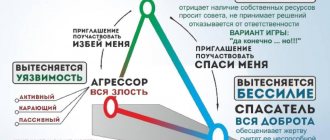“The victim is not really as helpless as he feels; The Rescuer doesn’t really help, and the Persecutor doesn’t really have any valid claims.” Claude Steiner, psychologist, psychotherapist
- Karpman triangle: general description of levels
- Role #1 – Victim
- Role No. 2 – Rescuer
- Role #3 – Persecutor
- How to understand that you are in a triangle?
- How to get out of the Karpman triangle?
In 1968, transactional psychologist Stephen Karpman published an article that described a model of relationships between people, later called the Karpman triangle . It includes three roles: pursuer, victim and rescuer . The subjects of this triangle form so-called codependent relationships, and we will talk about them in more detail in another article. And today we’ll focus on the game itself and the roles in it - we’ll describe the behavior and typical features, give examples
, we will explain why these are codependent relationships and what are their features.
And most importantly, we will give advice on how to get out of the triangle
.
Karpman triangle: general description of levels
Transactional analysts call relationships within this triangle codependent.
. In psychology, this term refers to a destructive type of relationship. In them, behind external communication at one level (for example, adult - adult), hidden - that is, through gestures, speech, intonation - communication is transmitted at different levels: adult - child. The Karpman triangle is a prime example of such a model.
This is a closed, mutually beneficial system of figures dependent on each other:
- the pursuer
has a subject on whom he can pour out his own negativity, on whom he can take it out and at the same time blame this person for his troubles; - the victim
gets rid of responsibility for his life, shifts decisions to others, receives help, and also sympathy and support; - the rescuer
looks like a hero in his own eyes and in the eyes of other people and enjoys the role.
Games replace sincere communication filled with mature emotions and reactions. All participants are in a low-resource state, each of them lacks basic support, trust and self-love.
Immersing in one of these roles, a person begins to dissolve in illusions and ignore reality.
. In fact, he gradually loses himself, energy, personality and life. Getting out of such a relationship and throwing off the role you have taken on can be difficult, but it is possible. We'll talk about this below. In the meantime, a few important points:
- The roles of the Karpman triangle do not know gender
. Any of them can be played by both men and women. - Moreover, it does not necessarily involve only three people
. A group of people, including very large groups, including the people, the population of the country, can play one role or another. - Participants in a triangle can periodically change roles
, as well as change roles within other triangles - consciously or unconsciously. In other words, at work a person can be a persecutor, in a relationship with a spouse - a victim, with a child - a rescuer.
No matter how hard it is to believe, each participant receives his own “benefit”
in such destructive relationships.
The game tends to drag on and on, destroying lives
.
Let's look at how exactly this happens and what “benefits” players are looking for.
Role #1 – Victim
- Motto
: "I'm not okay, you're okay." - Feelings
: suffering, helplessness, shame, envy, fear. - Motive
: to be in the position of a child, not to take responsibility for your life. - Repressed
: aggression. - Quotes
: “so unfair”; “It’s not my fault, it’s them...”, “because of you I have...”; “I am not appreciated”; “You can’t imagine how much I suffered”; “nobody loves me”; “poor me, poor me.”
Description of the victim
There is an opinion that the triangle begins with the victim. It is she who provokes the reaction of others, and they occupy one of two poles - the side of pity or anger. The victim has not matured inside
- he is a child who is not ready for decisions, choices, and responsibility for them.
Hidden aggression
gradually accumulates behind external helplessness , and the victim turns into a persecutor: “help” - “you’re not helping well,” “it’s all because of you.”
The victim occupies a position “under”, and therefore does not have freedom and is under control. The “benefit” that the victim seems to receive: the opportunity to feel sorry for himself, remain inactive and not change anything
.
See also the article “Victim Syndrome”
Examples
Anna has been living with Sergei for 3 years, hoping that he will pay off the loans and rent a larger house, then their life will improve, he will stop being rude and humiliating her. She is depressed, he threatens to break up with her, at these moments she experiences strong fear and a feeling of loneliness, begs him to come back.
Nina complains to her son about her tyrannical husband. My son is 38, he met a girl and decided to move in with her. Every day he receives sad calls and SMS about another scandal and his mother’s poor health. He breaks down and goes to the rescue every time. His relationship with his girlfriend is heating up.
What are the benefits?
- The victim is “comfortable” to feel offended; she constantly suffers. Often the Victim herself incites the Aggressor. Emotions of the victim: resentment, suffering, guilt, shame, envy.
- The main feature of the Aggressor is the desire to dominate the Victim through manipulation and control to increase self-esteem. Aggressor's emotions: irritability, anger.
- The Rescuer asserts himself through pity for the Victim and the desire to protect her. Emotions of the Rescuer: resentment, anger, pity, guilt.
There is tension in the body of the Victim, Aggressor, and Rescuer, which can later develop into psychosomatic diseases.
All three roles shift responsibility for their emotions, feelings, and their lives onto the shoulders of others. Everyone is afraid to be sincere and honest, first of all, with themselves. They do not want to realize the destructiveness of such relationships. There can be no talk of any personal growth here.
Role No. 2 – Rescuer
- Motto
: “I'm okay, you're not okay” (“You're helpless and hopeless, yet I'll try to help you”). - Feelings
: guilt, pity, pride. - Motive
: desire to assert oneself, to be needed, “good.” - Repressed
: helplessness. - Quotes
: “he/she can’t cope without me”; “how will I leave her/him”; “I advise you...”, “I feel sorry for you.”
Description of the rescuer
No matter how paradoxical it may sound, the rescuer here seeks to save not the victim at all, but himself
. Rushing to help, he recognizes himself as stronger, more capable, kinder, and more knowledgeable. He is engaged in the life of another, and this allows him to not think about his own life, problems, plans, etc. Salvation helps to rise, assert oneself and take a place “above” in these relationships. He wants to play the role of a “good boy/girl” in order to earn the recognition of others, but in fact, the recognition of his parents, which he was unable to feel in childhood.
Confusion of motives does not give joy from the assistance provided. Having not received due gratitude, the rescuer is in a low-resource, tired state
and, having strengthened control, can move into the role of a pursuer.
Examples
Elena is married to Sergei, he is an alcoholic. For more than 10 years, nothing has connected them except their son, a shared apartment and the past. She is afraid that Sergei will not cope and will not survive without her, so she maintains the relationship in the hope of a happy ending. She feels tired and frustrated.
Svetlana is 35 years old, her mother is sick after a stroke that happened 2 years ago. Mom is on bed rest. Every day after work, Svetlana rushes home to look after and help. She has no time to start relationships with men. Sometimes she spends time with her friends or relaxes, that is, she is not at work or with her mother, and during these short periods she feels guilty before her mother. Svetlana is confused and despondent. She is tired and feels the situation is hopeless.
When the main fuel for good deeds is anger
The “entry points” into the Karpman triangle for the volunteer and the mentee are usually the roles of rescuer and victim. Our ward enters from the victim, and we usually enter from the rescuer. Anger, which appears as an aggressor, is a very important force. Since in an unhealthy relationship it is difficult to have God as a source of strength, the driving force, the fuel, is anger, this is a very toned, strong feeling that helps us stay afloat, even when we are very tired.
Here is an interesting point of view: we believe that God wants us to help people and share our time, talents and money with them. But I also believe that He wants us to give from a place of high self-respect. I think acts of kindness are not kind unless we feel good about ourselves when we do it and about the person we are doing it for. If we absolutely cannot feel good about what we are doing, my radical view is that we should not do it at all, no matter how charitable it may seem to us.
Role #3 – Persecutor
- Motto
: “I'm okay, you're not okay” (“You're helpless and hopeless and it's your fault”). - Feelings
: anger, irritation, fear. - Motive
: desire to assert oneself, to gain the upper hand. - Repressed
: vulnerability. - Quotes
: “it’s your own fault,” “you don’t understand well”; "You provoked me."
Description of the pursuer
Often persecutors become people who were offended, scolded, and severely punished in childhood. They have received this impulse of cruelty and pass it on
, subconsciously trying
to compensate for the feeling of helplessness and shame
. By offending, persecuting, humiliating, reproaching, they take the “above” position and feel superior to the victim.
The “joy” of such self-affirmation is painful and destructive, because deep down cruelty does not help cure the pain. The persecutor is unhappy and feels like a victim.
Examples
Andrey lives with his wife. From his point of view, she is not capable of anything, and the whole house, finances and decisions are entirely on him. He does not consult with her, considering it pointless. At every opportunity, he tries to catch on and reproach him for stupidity and slowness. Periodically “let off steam” at her for the negativity that has accumulated during the day at work.
Alla lives with her seven-year-old son. The marriage did not work out; her husband left her with a child in her arms. Unconsciously, she is angry with her son and blames him for her difficult life, filled with everyday life, troubles, and unloved work. She is annoyed by the noise and chaos he makes at home. She yells at him, reproaches him, and often punishes him, which is why the son no longer obeys and does the opposite. She feels trapped in an unfair life situation.
How to understand that you are in a triangle?
Follow yourself:
- How often do you complain about life, your husband, your neighbor, your boss, or the government?
- How often do you discuss bad news in conversations with friends and acquaintances?
- How often do you help and advise, even if you were not directly asked or asked for it?
- How often do you blame other people (both close and not so close, for example, the government) for your own problems?
- How often do you find yourself thinking that others are luckier than you?
If you answered “Often” to at least one of the questions, you are most likely in the game
.
And not necessarily in relationships with your spouse or family members. You can walk in circles of this triangle endlessly, but to get out, you need to mature psychologically
. How to do it?
How to get out of the Karpman triangle?
I. Transfer the focus of attention from others to yourself, your desires, personal growth and development
. You can do this yourself by keeping a diary and reflection (we'll talk about this in more detail below). Or you can - at an appointment with a psychologist or through training in the direction of “personality psychology”.
II. Many people know three subpersonalities according to E. Berne: that inside us there is a child, a parent and an adult.
- A child
is that part of the Self that has been preserved inside us since childhood, from the age of 4-5. This is a living, defenseless and reverent part that is responsible for our feelings, emotions, desires. - The inner parent
is the part copied from your parents or significant adults. - The inner adult
is the part that analyzes reality, chooses an adequate response, and is responsible for will and decision-making.
For personal growth you need:
- Develop the adult part
. To do this, you need to reflect more often and analyze your behavior. Do exercises to develop concentration. Ask yourself questions:- What's happening now?
- What am I doing?
- Why am I doing this?
- Does it benefit me or harm me?
- What can I change, improve?
- Take care of your inner child
. You need to pay attention to him, give him care and warmth. Through self-dialogue, find out what he would like and do it. There are effective podcasts and meditations on this topic. In psychotherapy, in order to hear oneself, they use the “hot chair” method, where next to themselves they mentally imagine their childish part in the mind of a boy or girl and conduct a dialogue with him, hug him, promise to take care of him. If your inner child is happy and warm, you will have the resources to live your life, you will have interest in yourself, plans, and hobbies. The idea of playing games will become dull and uninteresting; it will be a pity to waste your time on it. - Transform the inner parent from a critic to a supporter
. Every time you hear criticism within yourself (“you were wrong again,” “what a freak,” “no one is waiting for you there,” “no one will like your work”), you will remember the joke: “You draw poorly.” - And you criticize badly. Replace criticism with praise and support - first correct yourself as part of the exercise, and then it will automatically become a habit.
III. If the game doesn’t let you go, it means that secondary benefits are more attractive to you than the idea of living your life
. Become aware of them, reflect: are they so great that you waste the time that fate has given you on illusions and manipulations. When your subpersonalities come into balance, the inner adult part will have the resource to take responsibility for its own life, let go of control and allow others to be adults, independent and make their own choices. You will have an interest in fulfilling yourself, manifesting yourself, living without disturbing others. As a result, codependent relationships will become meaningless and unattractive for you.
Remember, if you cannot get out of the Karpman triangle on your own, do not neglect contacting a specialist.
SHADOW
I want to say something special about the Shadow, without this part of the personality that you hide from yourself, don’t love, deny, there will be no progress. There will be no new happy life for you, there will be no transition to a new level of development.
It’s difficult to work out the Shadow on your own; your whole being will scream and moan: “I don’t want to go there!”
Why? Because. that you have always been taught and you yourself are sure that you CANNOT BE LIKE THIS!
Which one? And here again I have to say that we are all different. and each Shadow has its own unique face. You can touch a little yourself - watch the people who irritate you. Your Shadow is similar to them. You need to learn to be bad from people you don't like.
This is the most painful part of the process and requires the most energy. There are many other exercises that will help you see your Shadow and integrate it into your personality. But you should start by learning from your ANTI-idols.
Take your time, practice one quality per week. You will have a lot of resistance , I have observed this process more than once in my personal work on myself and with my clients.
But after this you will receive incredible power , which, like a rocket, will allow you to overcome the “-1” level of the Karpman triangle and go through polarity.






